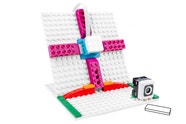SPIKE™ Essential
Literary Randomizer
How can Daniel’s literary randomizer make picking a book more exciting?
30-45 min.
Beginner
Grades 3-5

Prepare
- Review the Literary Randomizer lesson in the LEGO® Education SPIKE™ App.
- If necessary, pre-teach these related vocabulary words: genre, overwhelmed, randomizer, and success.
- Consider the abilities and backgrounds of all your students. Differentiate the lesson to make it accessible to everyone. See the Differentiation section below for suggestions.
- If time allows, plan and facilitate the language arts extension. See the Extension section below for more information.
Engage
(Whole Class, 5 Minutes)
- Facilitate a quick discussion about making decisions.
- Talk with your students about when they had to make a big decision.
- Ask questions, like: What criteria did you use to make the decision? How did you evaluate whether you were happy with your decision?
- Introduce your students to the story’s main characters and the first challenge: programming the literary randomizer to pick a book.
- Distribute a brick set and a device to each group.
Explore
(Small Groups, 30 Minutes)
- Have your students use the LEGO® Education SPIKE™ App to guide them through their first challenge:
- Create and test the program that picks the book genre.
- Have your students iterate and test their models to complete the next two challenges in the app:
- Modify the program to improve how the literary randomizer works.
- Design your own upgraded literary randomizer.
- You can find coding and building support in the Tips section below.
Explain
(Whole Class, 5 Minutes)
- Gather your students together to reflect on their completed challenges.
- Ask questions, like: What was Daniel’s problem? How did you help solve it? How did you improve Daniel’s literary randomizer? Why did you decide to improve that?
Elaborate
(Whole Class, 5 Minutes)
- Prompt your students to discuss and reflect on the process of setting success criteria to determine whether a solution was successful.
- Ask questions, like: Why is it important to set success criteria and understand what makes a solution successful? How do success criteria help you to improve something you've created?
- Have your students clean up their workstations.
Evaluate
(Ongoing Throughout the Lesson)
- Ask guiding questions to encourage your students to “think aloud” and explain their thought processes and reasoning in the decisions they've made while building and programming.
Observation Checklist
- Measure your students’ proficiency in defining success criteria to evaluate a solution.
- Create a scale that matches your needs. For example:
- Needs additional support
- Can work independently
- Can teach others
Self-Assessment
- Have each student choose the brick that they feel best represents their performance.
- Yellow: I think I can define the success criteria for evaluating a solution.
- Blue: I can define the success criteria for evaluating a solution.
- Green: I can define the success criteria for evaluating a solution, and I can help a friend do it too.
Peer-Feedback
- In their small groups, have your students discuss their experiences working together.
- Encourage them to use statements like these:
- I liked it when you…
- I'd like to hear more about how you…
Tips
Coding Tip
- After your students complete their first challenge, they'll be provided with three Inspiration Coding Blocks to help them modify their programs.
- The Inspiration Coding Blocks are intended to spark their imaginations as they experiment to find their own solutions.




Model Tip
- After your students complete their second challenge, they’ll be provided with three Inspiration Images and an open-ended prompt for improving their models.
- The Inspiration Images are to help spark their imaginations as they experiment and personalize their models.




There aren't any building instructions for this challenge.
Differentiation
Simplify this lesson by:
- Selecting one Inspiration Image to help your students personalize their models
- Experimenting with either the coding or the building
Increase the difficulty by:
- Changing how the literary randomizer is constructed
- Exploring new and different coding blocks in the program
Extension
- Have your students write stories based on the genre chosen by their literary randomizers. Make sure that they use narrative techniques, such as dialogue and description, to create a story that fits the genre.
If facilitated, this will extend beyond the 45-minute lesson.
Language Arts: CCSS.ELA-LITERACY.W.5.3
Teacher Support
Students will:
- Define success criteria to help evaluate a solution
- Compare and contrast different solutions to determine which one meets the specified need
- Engage effectively in a range of collaborative discussions
(one for every two students)
- LEGO® Education SPIKE™ Essential Set
- Device with the LEGO® Education SPIKE™ App installed
- CSTA 1B-AP-10
- NGSS 3-5 ETS1-2
- ISTE 1.4a
- CCSS.ELA-LITERACY.SL.5.1
Language Arts Extension
- CCSS.ELA-LITERACY.W.5.3




